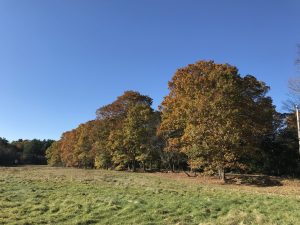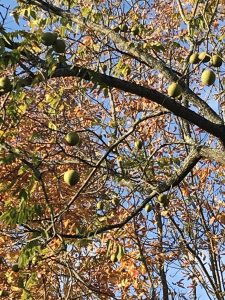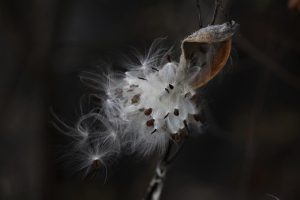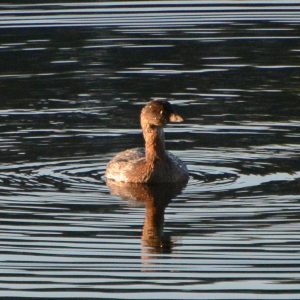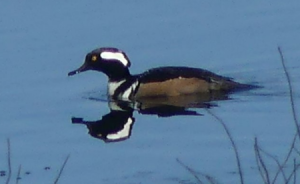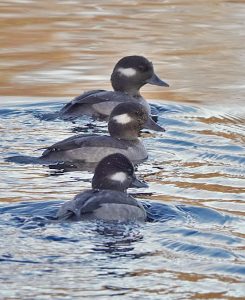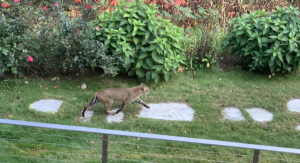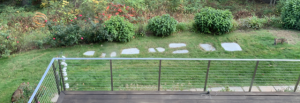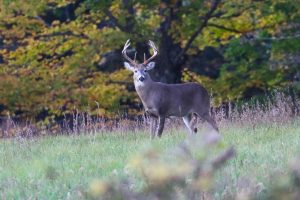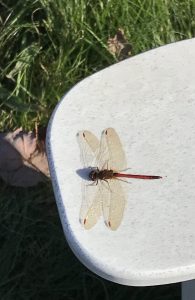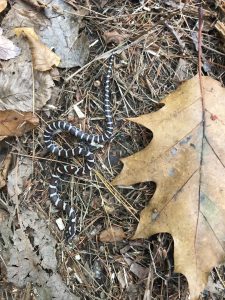Written by Gwyn Loud for the Lincoln Land Conservation Trust. She welcomes your sightings and questions at 781-259-8690 or gwynloud555@gmail.com.
We have had a beautiful autumn, with prolonged colorful fall foliage, although more muted in tone than some years. The reds are mostly gone by now, but oaks and maples are still displaying their gold and russet beauty, and some trees persist in staying green. A notable weather event was the Nor’easter on October 27-28, but Lincoln was spared the severe winds and power outages which occurred in coastal areas. The first town-wide hard frost came late, on Nov. 3-4, although low-lying places had frost earlier. A few feet in elevation can make a difference. Unusually warm temperatures occurred on many days, and my thermometer read 70℉ on November 9. Global warming seems pleasant until we think about the implications.
Berries of all sorts abound, including winterberry, barberry, poison ivy, inkberry and multiflora rose, and robins and cedar waxwings have been busy eating the fruits of my flowering crabtrees. If you saw what looked like green tennis balls under a tree, you were looking at the fruits of the back walnut. Small numbers of acorns and cones mean that this is not a mast year, and birds and mammals which count on those food sources will feel the impact.
The fall bird migration is winding down, with late migrants such as yellow-rumped warblers, American pipits, Lincoln’s sparrows, white-crowned sparrows and rusty blackbirds still coming through. A few hardy individuals of birds such as Northern flickers, gray catbirds, pine warblers, red-winged blackbirds, and hermit thrushes will stay through the winter, but most will move south. Purple finches (easy to confuse with house finches) and American tree sparrows have recently been spotted and both will frequent bird feeders. Each year the “Winter Finch Forecast”, based on how plentiful the food supply is in Canada, tells us what to expect in terms of seeing irruptive species such as pine siskins, redpolls, and red-breasted nuthatches here in New England. It looks like this will not be a big irruptive year as the boreal forest is producing well.
Ducks are appearing on ponds as usual at this time. Flint’s Pond recently hosted wood ducks, ring-necked ducks, bufflehead, common golden-eyes, hooded mergansers, and common mergansers. On Farrar Pond observers saw mute swans and a trio of pied-billed grebes. For several months great blue herons have been reported far from their usual waterside habitats, most recently in Browning Field. It’s possible all the rain created more wet patches in fields and woods. Certainly there have been toads and frogs in these habitats, providing good heron meals. A resident by Farrar Pond wrote, “My goldfish have been safe for a decade, but suddenly last week a great blue heron scouted our garden, ate my fish, and stalked the chipmunks. Oh well.” Other recent notable bird sightings have been golden-crowned kinglets, a vesper sparrow at Drumlin Farm, and a winter wren. A rare European goldfinch was seen by a birder at Boyce Field.
Most of our common mammals, including rabbits, mice, beavers, red and gray squirrels, deer, fishers and coyotes are active throughout the winter. They have various adaptations to make it through the season, such as changing diet or growing a thicker fur coat. Chipmunks become semi-dormant, primarily staying underground and feeding on stored food caches. Likewise, raccoons are generally dormant, and may hole up in tree cavities, emerging to find food during milder spells. Woodchucks put on a lot of body fat in late summer and this will sustain them in their winter burrows. They are true hibernators; their metabolism slows, their heart rate drops from 100 to 15 beats per minute, and body temperature goes from 97℉ to 47℉.
Recent mammal reports include red foxes, an opossum crossing Weston Rd., coyotes, skunks, raccoons, and a dead fisher on Trapelo Rd. Tidy cone-shaped holes in your lawn are signs of striped skunks searching for grubs or other food. For the third month in a row bobcats were seen, this time two (that means there will be more…) in a backyard on Acorn Lane, not far from the Ricci Fields. Beavers have been active all fall collecting branches of favorite foods such as willows, maples, red osier dogwoods, and birch to be a winter food supply. The beavers can access their lodges underwater even when the ponds are frozen.
Recent warm days have brought out insects, even a few mosquitoes, and crickets were chirping in the sun. I was happily surprised to have a couple of meadowhawk dragonflies join me on a deck chair. Stink bugs have appeared inside houses again and we still need to check for ticks after walking in woods and fields. The warmth also appealed to snakes, and many walkers reported seeing either garter snakes or milk snakes along roads, a few squashed by cars, sadly. Once the cold weather really sets in snakes as well as turtles and amphibians go into brumation, which is dormancy for cold-blooded animals. Their metabolism slows dramatically and they sleep in sheltered places. For snakes this might mean burrowing into the ground or curling up in rock wall crevices. Aquatic frogs, such as bull frogs and green frogs, go to the bottom of the pond and absorb enough oxygen through their skin. Salamanders and terrestrial frogs such as wood frogs burrow under logs or into leaf litter and they can survive below-freezing temperatures as their bodies actually generate a sort of “anti-freeze.”
Looking skyward, if you rise before dawn on Nov. 17-18 you might see the Leonid meteor showers. On Nov. 19, as described in Mass Audubon’s Almanac, the full Beaver Moon will rise, “ accompanied by a near-total eclipse! The near-total lunar eclipse will be visible from most of North America, reaching its maximum at approximately 4 AM Eastern Time today. Why the “Beaver” Moon? This is the time of year when beavers begin to take shelter in their lodges, having laid up sufficient stores of food for the long winter ahead. During the time of the fur trade in North America, it was also the season to trap beavers for their thick, winter-ready pelts.”
© Gwyn Loud
Links


